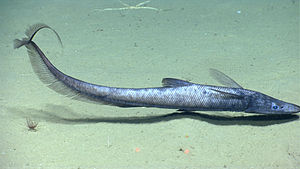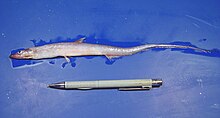Lizard eels
| Lizard eels | ||||||||||||
|---|---|---|---|---|---|---|---|---|---|---|---|---|

Indeterminate lizard eel at a depth of about 2000 meters in Veatch Canyon (northwestern Atlantic). |
||||||||||||
| Systematics | ||||||||||||
|
||||||||||||
| Scientific name | ||||||||||||
| Halosauridae | ||||||||||||
| Günther , 1868 |
The lizard eels (Halosauridae) live with 16 species in three genera worldwide in the deep sea. The name comes from the Greek and means "marine iguana". However, the animals are not lizards, but real bony fish .
features
The animals have an elongated body, with a pointed, whip-shaped tail that, like lizards, can be regenerated when lost. The anal fin is the largest fin and runs to the end of the tail. The mouth is low, the eyes large. Lizard eels have large cycloid scales . The sideline runs along the edge of the abdomen, there may be light organs on it , they have no swim bladder . Lizard eels are usually gray, brown or black. Some live animals have been filmed from remote-controlled vehicles .
The largest species is the 90 centimeter long Halosauropsis macrochir , which was found at a depth of 3300 meters. The remaining species are between 34 and 68 centimeters long.
Way of life
Lizard eels move slowly at the low temperatures of approx. 4 to 10 ° C with rhythmic vibrations of the body over the ground and wait for their prey consisting of worms, echinoderms and crabs.
Systematics
There are 16 species in three genera.
-
Aldrovandia
- Aldrovandia affinis ( Günther , 1877) .
- Aldrovandia gracilis Goode & Bean , 1896 .
- Aldrovandia mediorostris (Günther, 1887) .
- Aldrovandia oleosa Sulak, 1977 .
- Aldrovandia phalacra ( Vaillant , 1888) .
- Aldrovandia rostrata (Günther, 1878) .
-
Halosauropsis
- Halosauropsis macrochir (Günther, 1878) .
-
Halosaurus
- Halosaurus attenuatus Garman , 1899 .
- Halosaurus carinicauda ( Alcock , 1889) .
- Halosaurus guentheri Goode & Bean , 1896 .
- Halosaurus johnsonianus Vaillant, 1888 .
- Halosaurus ovenii Johnson, 1864 .
- Halosaurus pectoralis McCulloch, 1926 .
- Halosaurus radiatus Garman, 1899 .
- Halosaurus ridgwayi (Fowler, 1934) .
- Halosaurus sinensis Abe, 1974 .
Fossil genera:
literature
- Joseph S. Nelson : Fishes of the World . John Wiley & Sons, 2006, ISBN 0-471-25031-7 .
Web links
- Lizard eels on Fishbase.org (English)


